Understanding your target customer is the foundation of an effective marketing strategy. Segmenting customers by their psychographic characteristics—such as lifestyle, personality, and beliefs—helps you create more personalized messaging. One that speaks directly to buyer wants, needs, and expectations.
In this article, we’ll cover the ins and outs of psychographic market segmentation and explore different ways to apply it to your marketing strategies.
What Is Psychographics in Marketing?
Psychographics is a methodology for classifying the psychological factors that influence people’s choices and behavior.
This psychographics definition within a marketing context entails understanding what motivates customers to make purchases, stay loyal to a brand, switch to competitors, and engage in other consumer-related behaviors.
Why is psychographics important?
Psychographic analysis involves building an accurate picture of customer lifestyles, values, beliefs, and personalities to help you create more resonant, more successful marketing campaigns.
Psychographics often gets a mention alongside demographics. While the former looks at people’s psychological motives, the latter focuses on statistical regularities among groups—such as age, gender, and location.
Later in this post, we’ll look at how combining both of these analytical methodologies can help marketers better understand their target audiences.
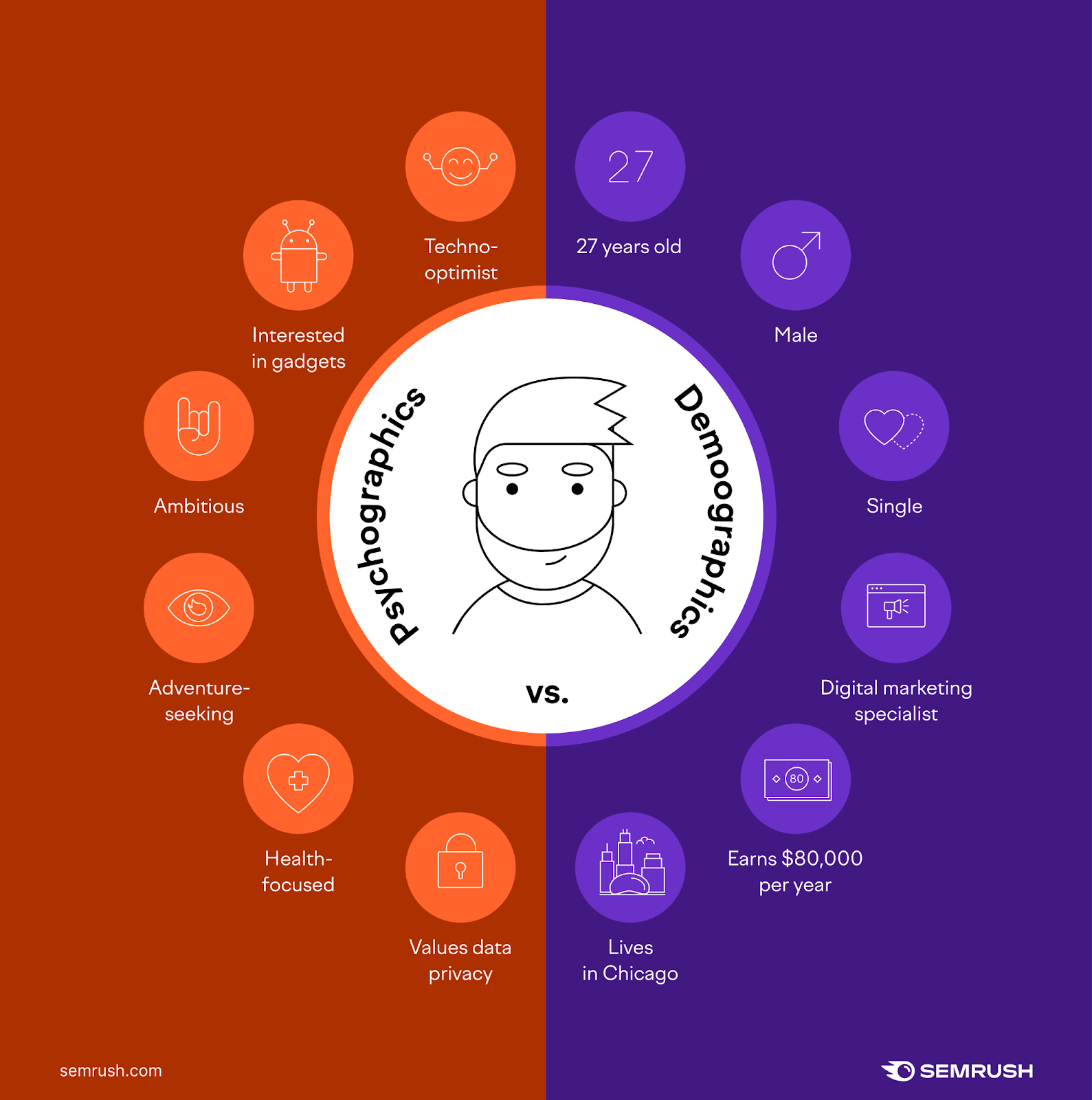
What Is Psychographic Market Segmentation?
Psychographics in marketing segmentation is the process of dividing a market based on the psychological factors that impact consumer behavior and decision-making.
By segmenting your target market into distinct psychographic profiles or audiences, you’ll be able to develop deeper explanations for the following:
- Why customers buy a particular product or service
- Why customers form loyalty towards a particular brand
- What type of messaging resonates most with customers
- What product benefits and features customers value most
- How social influences impact customer buying decisions
- How personal belief systems influence customer behavior
- What leads customers to switch brands
Further reading: Target Market 101: Definition, How to Identify It + Campaign Tips
The Benefits of Psychographic Segmentation in Marketing
Having a nuanced understanding of your customers’ underlying motivations can enhance your marketing efforts in several ways.
Here are some desired results you can achieve through psychographic marketing segmentation:
- Build a 360-view of your target audience. Your target market isn’t one homogeneous group. Psychographic segmentation reveals the unique preferences and behaviors of different sections of your customer base.
For instance, a fitness wear brand might find that its audience mainly consists of those who mainly exercise for social reasons and those driven by personal health goals. - Tailor your offer. Design offers that resonate more deeply with different customer profiles.
Consider a gourmet food delivery service whose customer base includes a significant portion that’s passionate about culinary exploration. So it decides to launch a “Chef’s Adventure Box” subscription. Offering monthly delivery of exotic ingredients, recipes from top chefs around the world, and access to an online community for sharing culinary creations with like-minded cooking enthusiasts. - Deliver personalized messaging. Craft more relevant, engaging marketing messages that directly address your customers’ specific emotions, concerns, and aspirations.
For example, a luxury travel company might identify that many of its customers value exclusive, once-in-a-lifetime experiences. In response, the company creates email campaigns focused on bespoke travel packages, with private tours and unique local activities not available to the general public. - Prioritize the proper channels. Understanding the online preferences and habits of different customer segments lets you capitalize on the communication channels they use the most.
Say a fitness supplements brand discovers that much of its audience frequently engages with influencer content and visual media. The brand then adapts to this preference by allocating more of its budget to platforms like YouTube and Instagram. - Improve product development. It’s easier to design products and services that align with your customers’ expectations and desires when you know what they truly care about.
Imagine a mid-sized, US-based clothing company that manufactures its products in Vietnam. The company’s psychographic research reveals that a large segment of its customer base values domestic manufacturing and supports local economies. As a result, the brand launches a “Made in the USA” clothing line, emphasizing the use of locally sourced materials and American craftsmanship. - Increase customer retention. When customers sense a brand is on their wavelength, it fosters a stronger emotional connection—leading to greater customer loyalty.
For example, a skincare brand might learn that many of its customers would appreciate personalized skincare advice. Therefore, the brand introduces a virtual consultation service where customers can receive tailored skincare tips and product recommendations from experts.
7 Key Psychographic Examples
When segmenting customers according to their shared psychological characteristics, market researchers typically consider the following psychographic dimensions.
Lifestyle Insights: Decoding Consumer Habits
Lifestyle refers to customers’ daily habits and covers things like work commitments, social engagements, housing arrangements, parental duties, relationship status, and leisure activities.
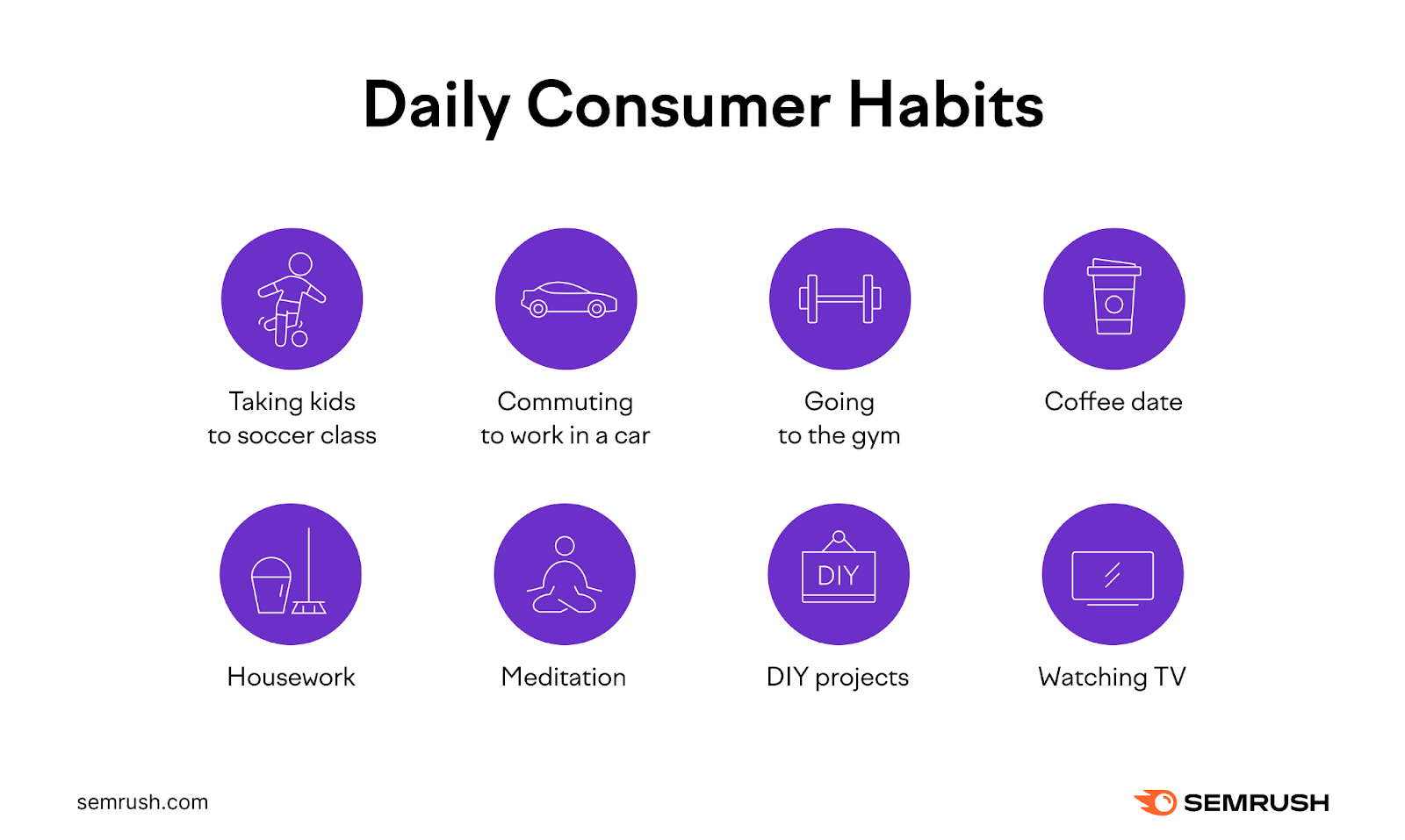
Knowing what factors influence the day-to-day decisions of your chosen target audience allows you to tailor your content strategy and messaging to the specific needs of different lifestyle segments.
Example: A meal kit delivery brand might develop a targeted marketing campaign for health-conscious working parents. The campaign could emphasize convenience alongside the nutritional aspect of the items provided.
Personality Profiles: Understanding Individual Traits
Personality encompasses the unique characteristics of a person’s behavior and way of thinking. Including the “Big Five” personality traits: openness, conscientiousness, extraversion, agreeableness, and neuroticism.
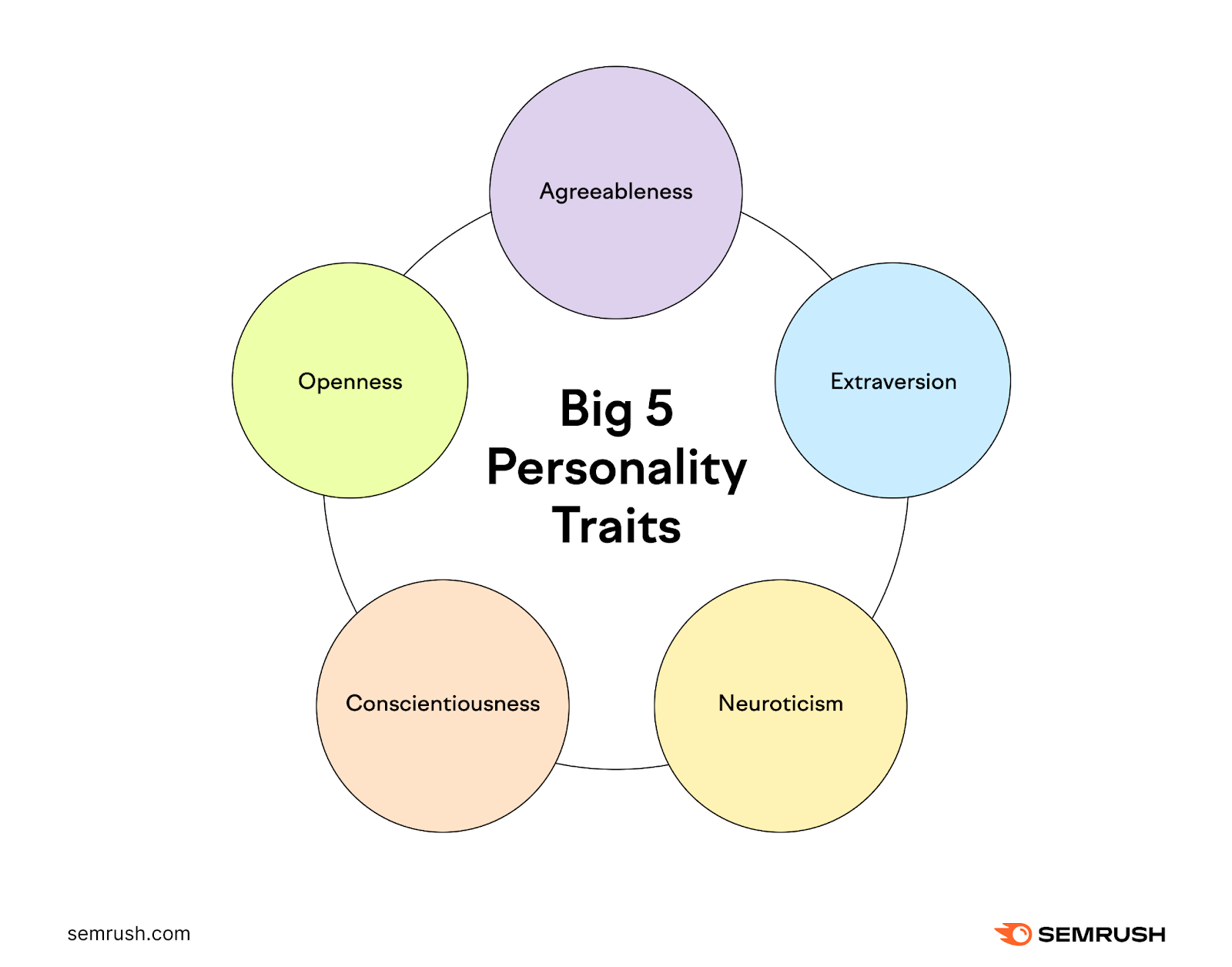
By analyzing personality types, your marketing team can create campaigns that resonate with different customers’ inherent tendencies.
Example: A streaming service could target introverted users with a campaign highlighting the joy of spending a quiet evening of movie watching at home.
Attitudes and Belief Systems: Gauging Consumer Mindsets
Attitudes and beliefs are mental stances and convictions that influence how consumers view the world and make decisions.
Understanding them can help marketers align their campaigns with consumer ideologies.
Example: Let’s take a campaign by a sustainable fashion brand as a use case. Highlighting the brand’s use of biodegradable packaging and commitment to ethical sourcing to appeal to consumers who support minimizing waste.
Activities and Interests: Identifying Consumer Preferences
Activities and interests refer to how consumers like to spend their time, including their hobbies and media consumption habits.
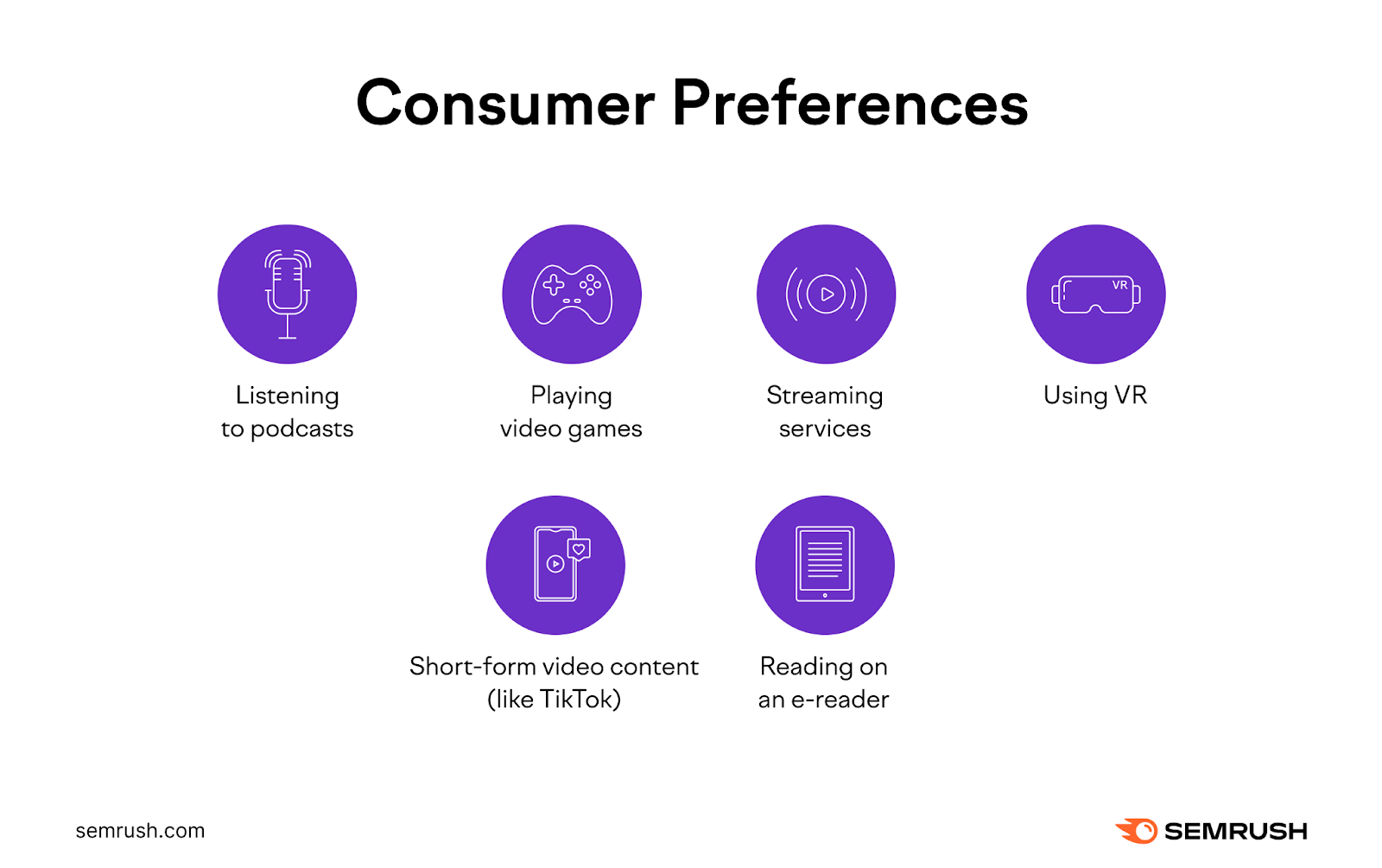
Knowing what consumers are passionate about helps your business develop products and marketing strategies that cater to their preferences.
Example: A sports equipment brand might target outdoor enthusiasts with a campaign centered around mountain biking adventures. Showcasing the durability of its biking gear for rugged terrains.
Social Status Dynamics: Impact on Consumer Choices
Social status plays a crucial role in consumer choices as individuals often make purchases to reinforce or enhance how others perceive them in society.
Marketers often capitalize on the gap between a consumer’s current social standing and where they aspire to be.
Example: Luxury car brands might market their more accessible models to those with middle incomes. That way, they position these vehicles as gateways to higher status.
Core Values: Unveiling Consumer Ethics and Morals
Core values are the fundamental beliefs that guide people’s decision-making. If your brand aligns with core values, you stand to build stronger connections with your audience. Those that conflict with these values risk alienating their customer base.
Take a cosmetics brand that strictly adheres to cruelty-free and vegan product standards. It could launch a campaign emphasizing its no-animal-testing policy and use of plant-based ingredients.
Lifecycle Stages: Adapting to Consumer Evolution
Lifecycle stages refer to the progression of a consumer’s relationship with your brand, from initial awareness through to loyalty and advocacy.
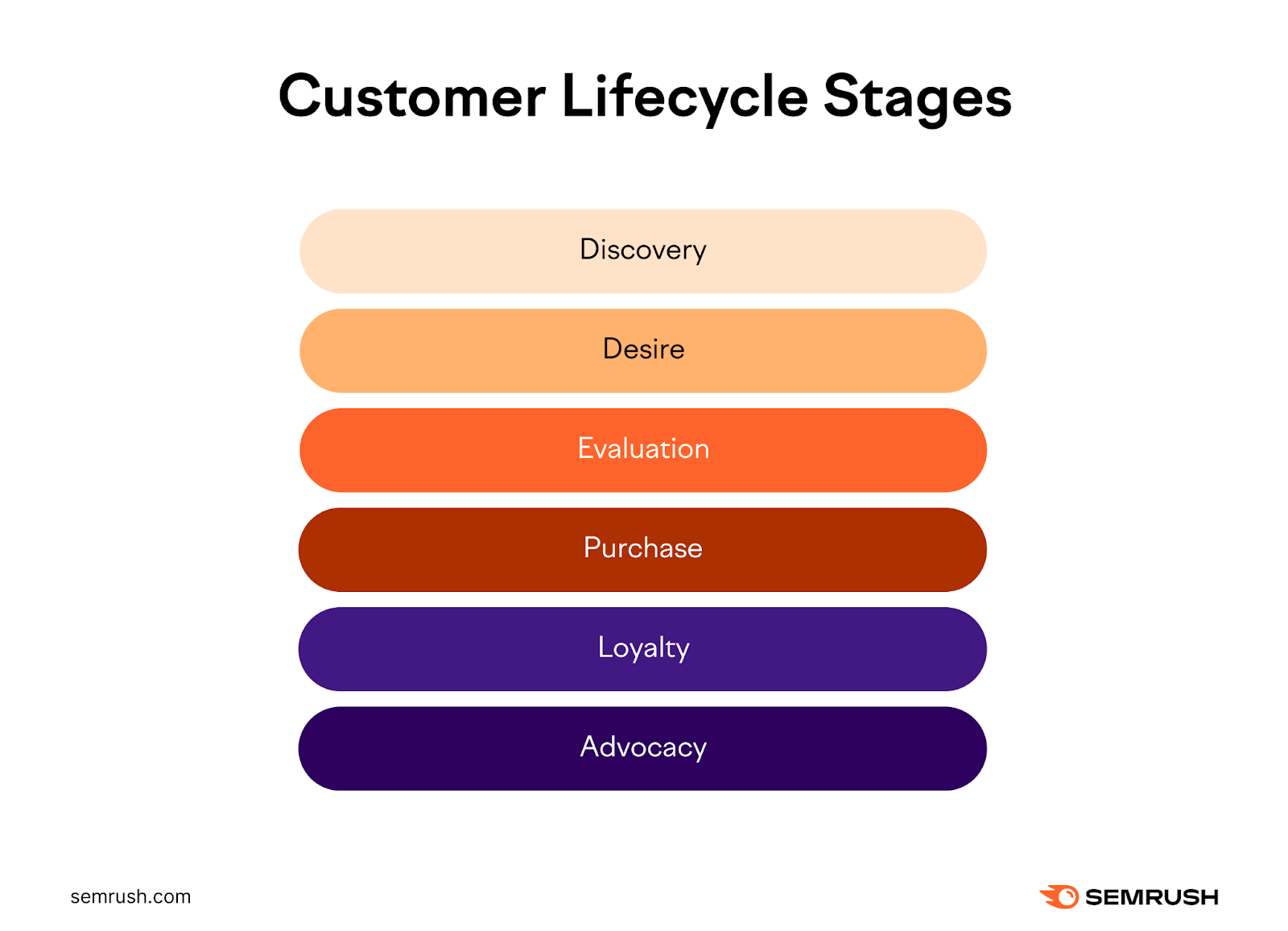
Understand where consumers fall within this spectrum to tailor your strategies to the evolving needs of buyers at each stage.
For example, a fitness app might offer free workout guides to new users to spark interest. Followed by a subscription deal on personalized fitness plans for those who engage regularly. Plus discounts on premium features to foster loyalty and encourage referrals from committed users.
Now we’ve identified seven different types of psychographic data that can support your marketing efforts, let’s look at how to gather this information.
Methods for Collecting Psychographic Data
We recommend the following effective techniques for conducting psychographic audience research.
Use Audience Research Tools
One way to gather psychographic data is through market research tools with audience analysis features, such as Semrush’s Market Explorer.
The tool gives you a quick snapshot of the general interests and media consumption habits of consumers within your market. Plus information about market size, your market share, and top competitors in your niche.
There are three ways to research your market landscape in Market Explorer.
Select “Create List” if you already know which industry players you want to analyze. Enter up to 100 competitor domains, name your list, select a desired location, and click “Create and analyze.”
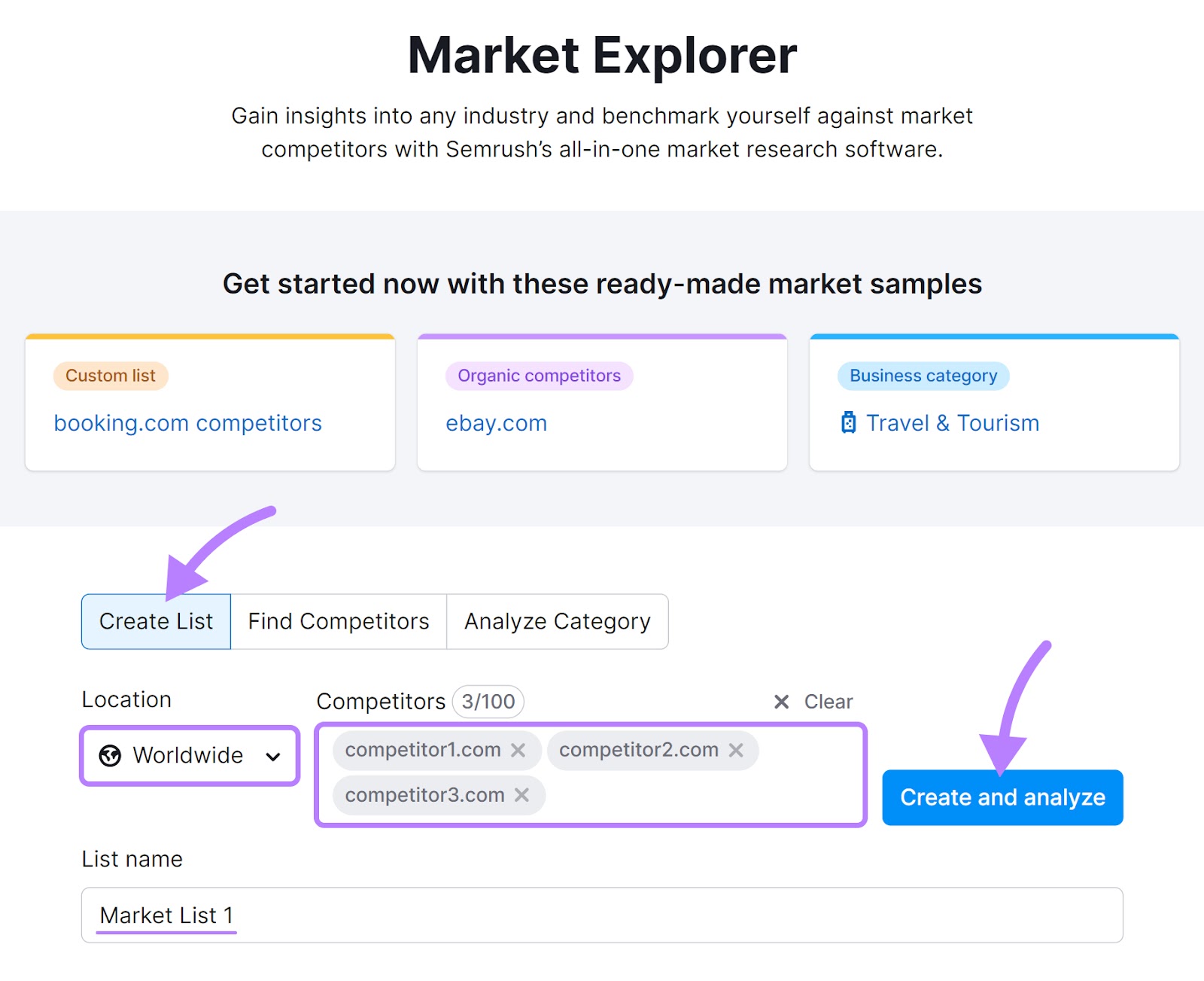
Click “Find Competitors” to learn who your competitors are. Enter your domain into the search bar, select a location, and click “Research a market.”

Or pick “Analyze Category” for a bird’s-eye view of a specific industry. Choose your business category, select a location, and hit “Research a market.”

Market Explorer will then generate four reports for your chosen market: “Overview,” “Audience,” “Benchmarking,” and “All Domains.”
You’ll find psychographic insights in the “Audience” report.
To illustrate, we researched UK-based sustainable clothing company Rapanui. We used the “Find Competitors” option to analyze the market for the brand’s top competitors.
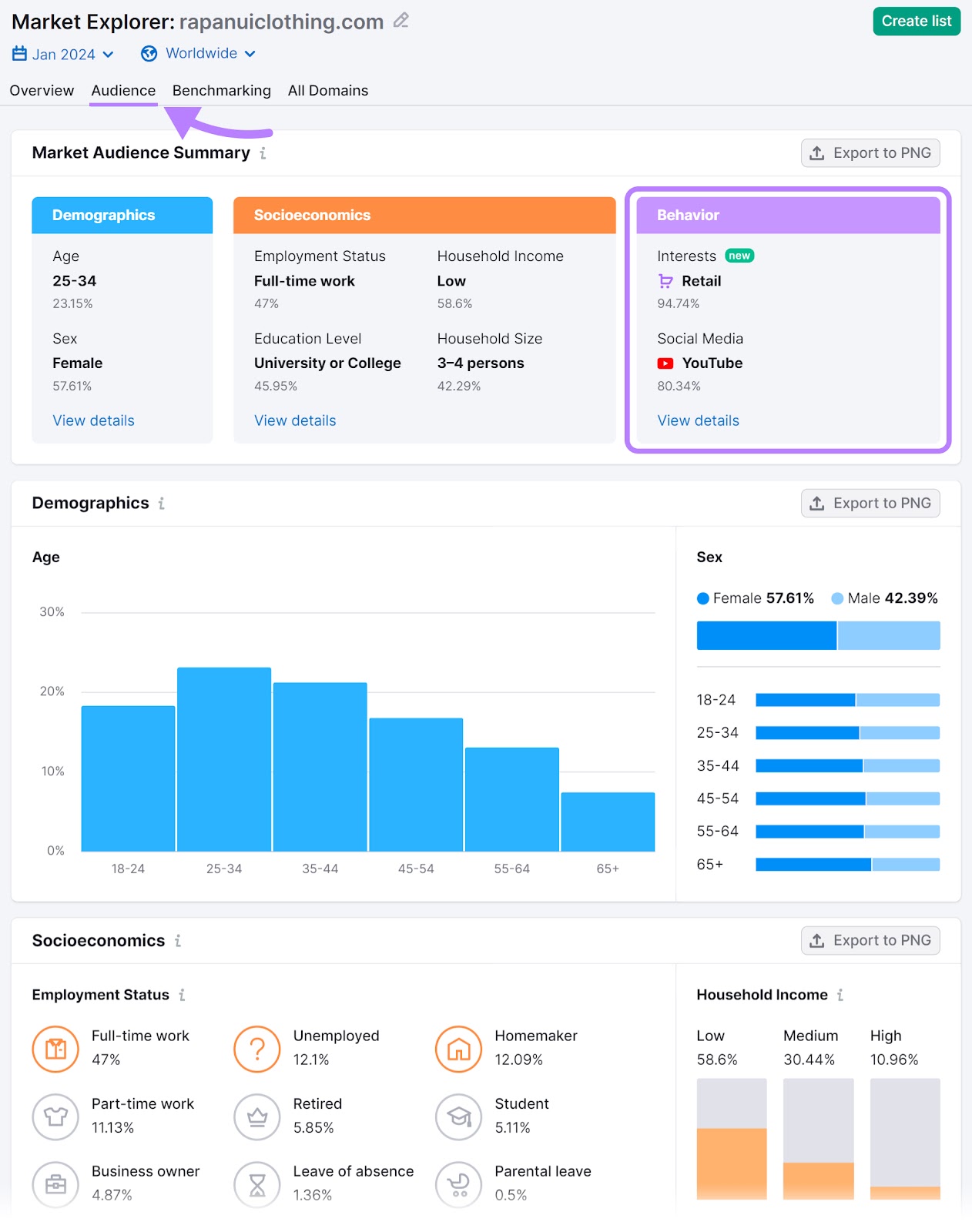
Here, we see a range of insights about the market’s demographic breakdown, socioeconomic characteristics, and psychographic information relating to audience interests and social media preferences.
In our example, the audience’s top interests are retail, education, and computer software and development. Their preferred social media channels are YouTube, Facebook, and Instagram.
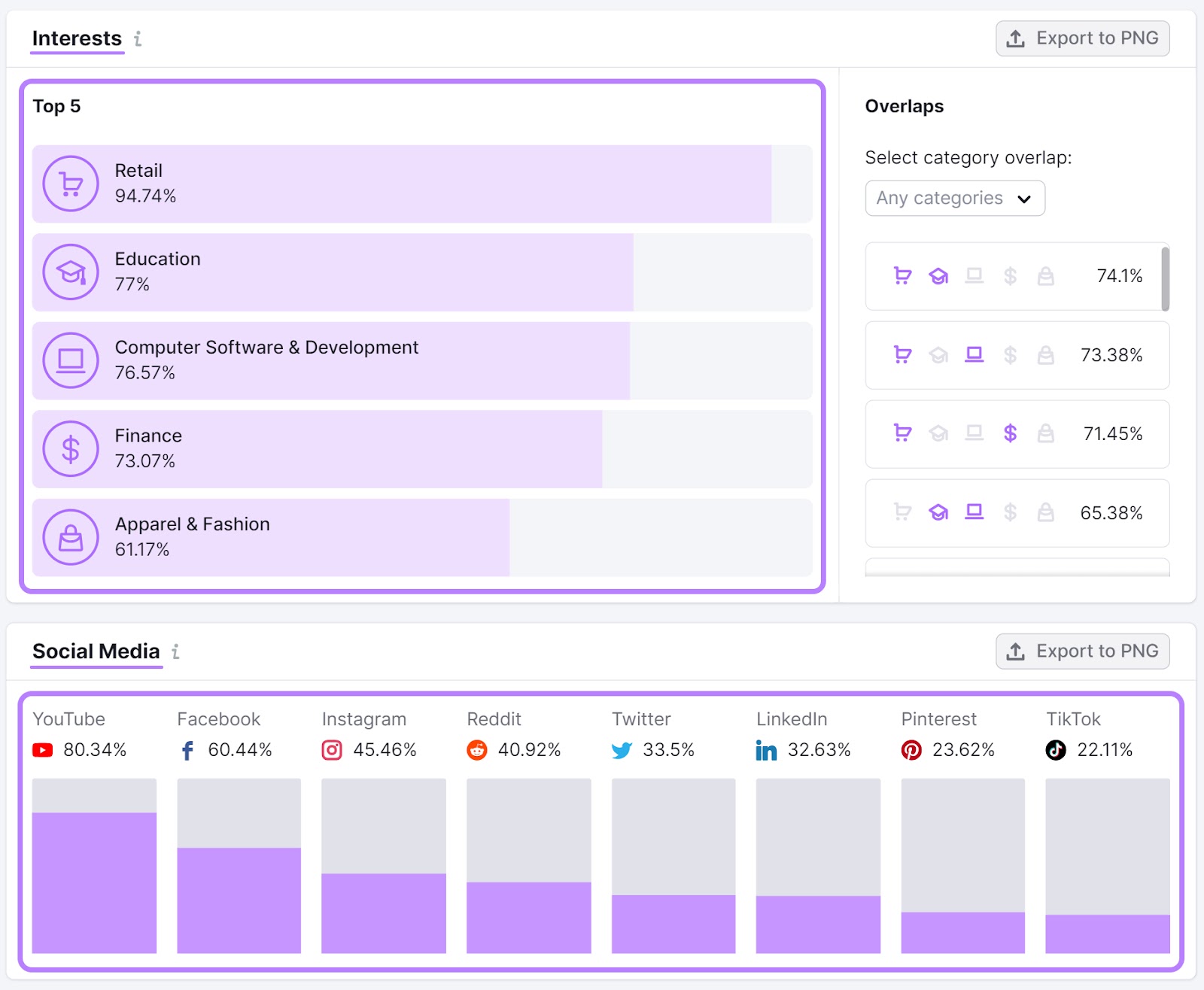
Market Explorer is great for understanding the broader market. But what if you want to dive deeper into your audience and see how it compares to a handful of your biggest competitors?
For that, you can use Semrush’s One2Target.
This tool also groups audience data into four reports, this time: “Demographics,” “Socioeconomics,” “Behavior,” and “Audience Overlap.”
Each report contains several metrics to help you understand your competitors’ audience—and your intended target audience—on a deeper level. Including data related to household sizes, employment status, interests, and preferred social media channels.
Using One2Target is simple. First, you’ll need to define your audience.
How?
Add one competitor’s domain at a time, or up to five simultaneously, using the “Check Competitors” option.
Or import a list of up to 100 domains for broader market insights and click “Create List.”
Here’s what that looks like, sticking to our example of Rapanui.
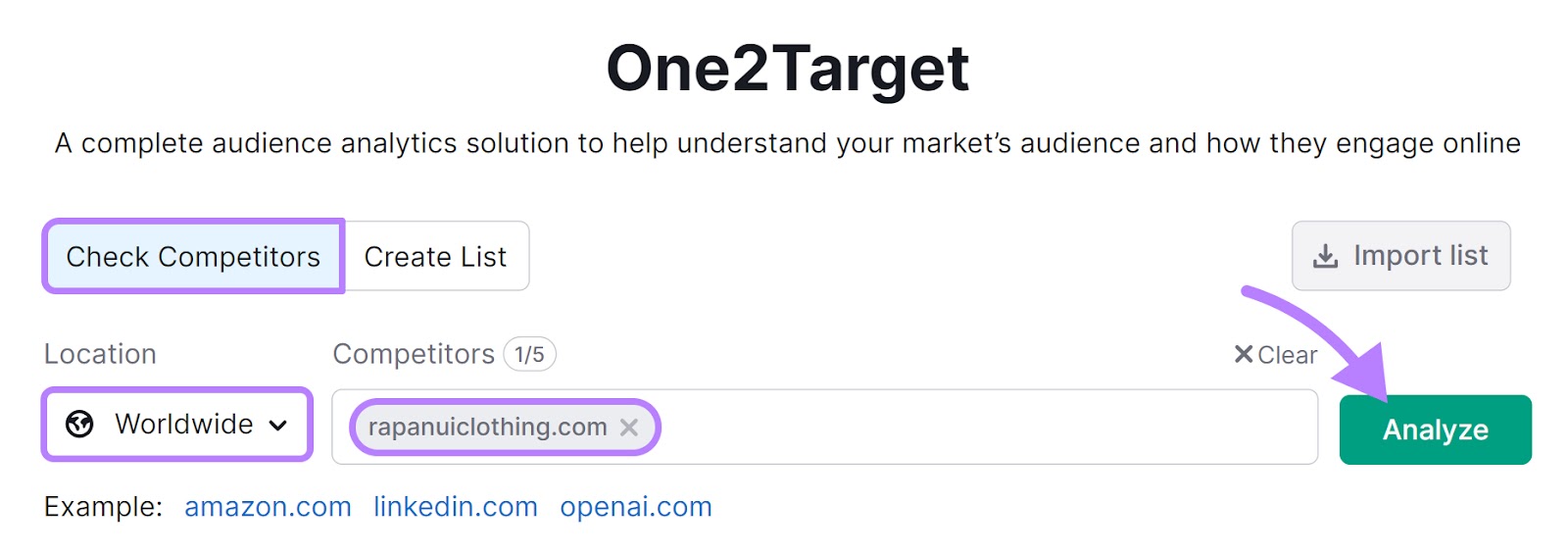
Next, select a location for your market audience. In our example, we set the location to “Worldwide.”
Finally, hit “Analyze” to generate your reports.
First, you’ll see the “Demographics” report.
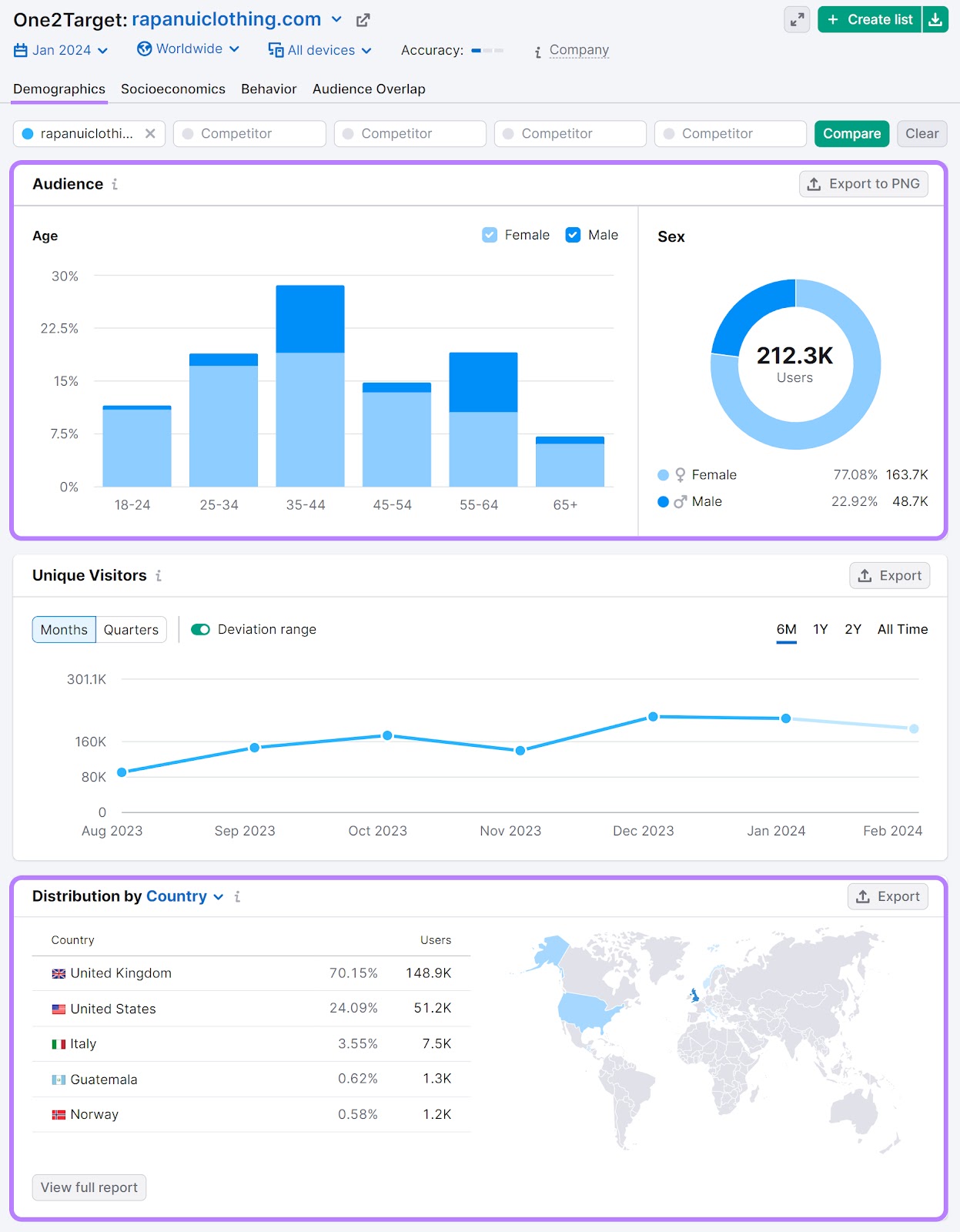
Which shows various demographic insights about your audience, segmented by age, sex, and geographical distribution.
Next, you’ll see the “Socioeconomics” report:
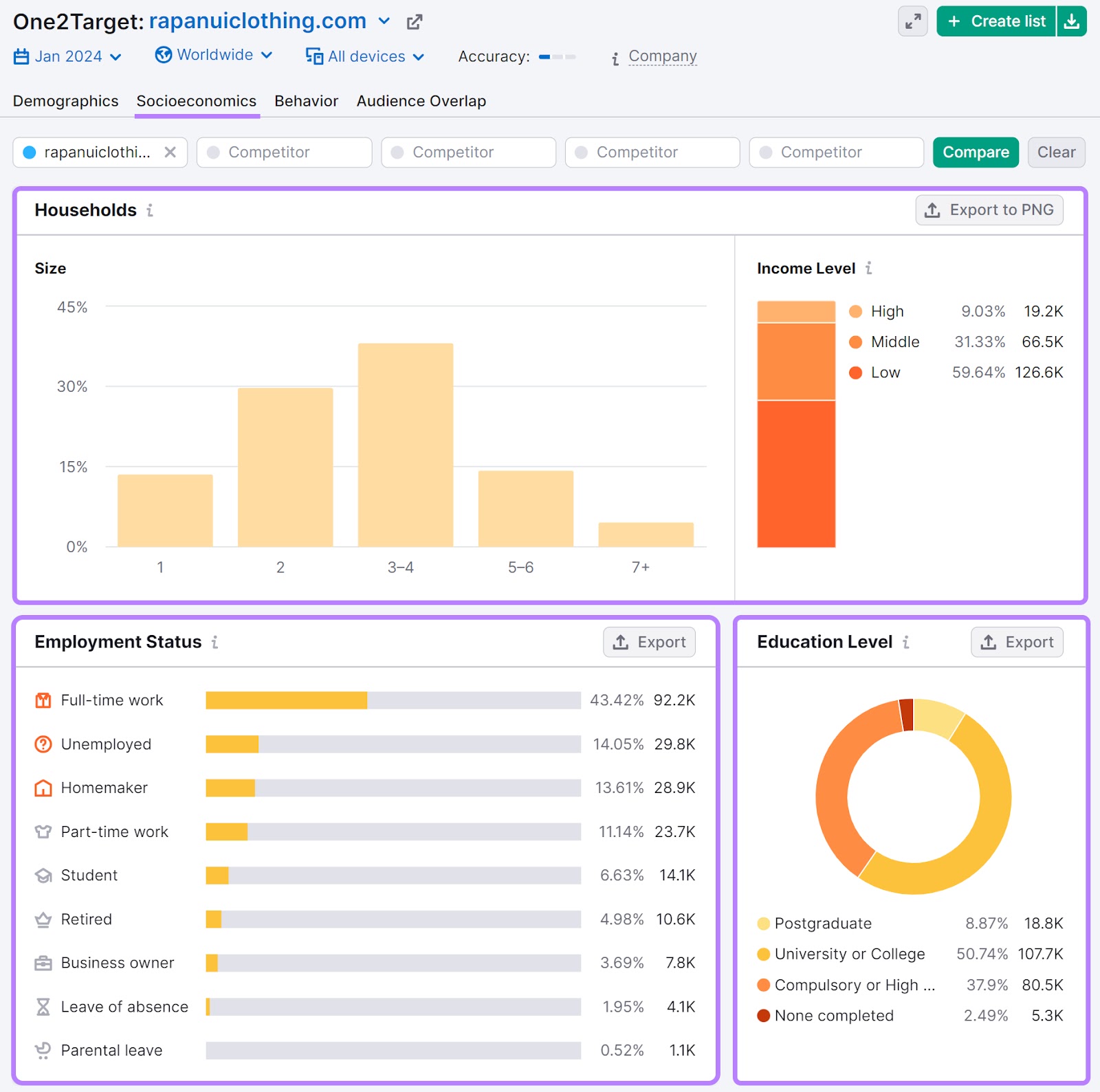
What could the data indicate about our target audience’s psychographic makeup?
As full-time workers, we might infer that they’re likely to seek out activities that help them unwind and disconnect from work—like yoga, meditation, or outdoor pursuits.
Their high education levels could imply an interest in continuous learning, personal development, and sustainability.
And a low-to-medium income could suggest a preference for affordability when making buying decisions.
Now let’s see what the “Behavior” report can tell us about audience preferences.
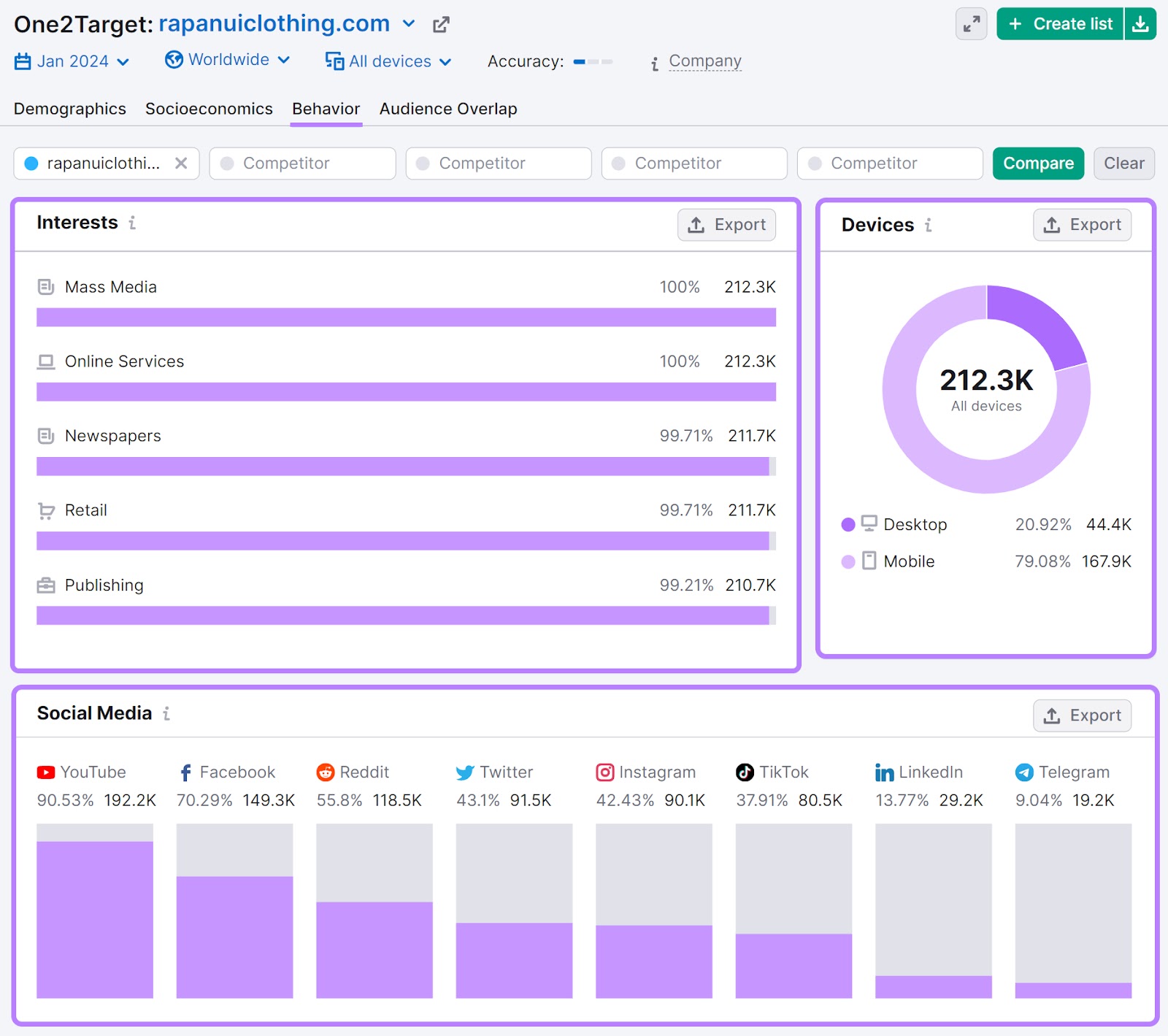
The majority use their mobile to access channels like YouTube, Facebook, and Reddit—the three most popular social platforms in this case.
We also checked out Patagonia, an outdoor wear brand committed to environmental sustainability.
Here’s what Patagonia’s “Socioeconomic” report looks like:
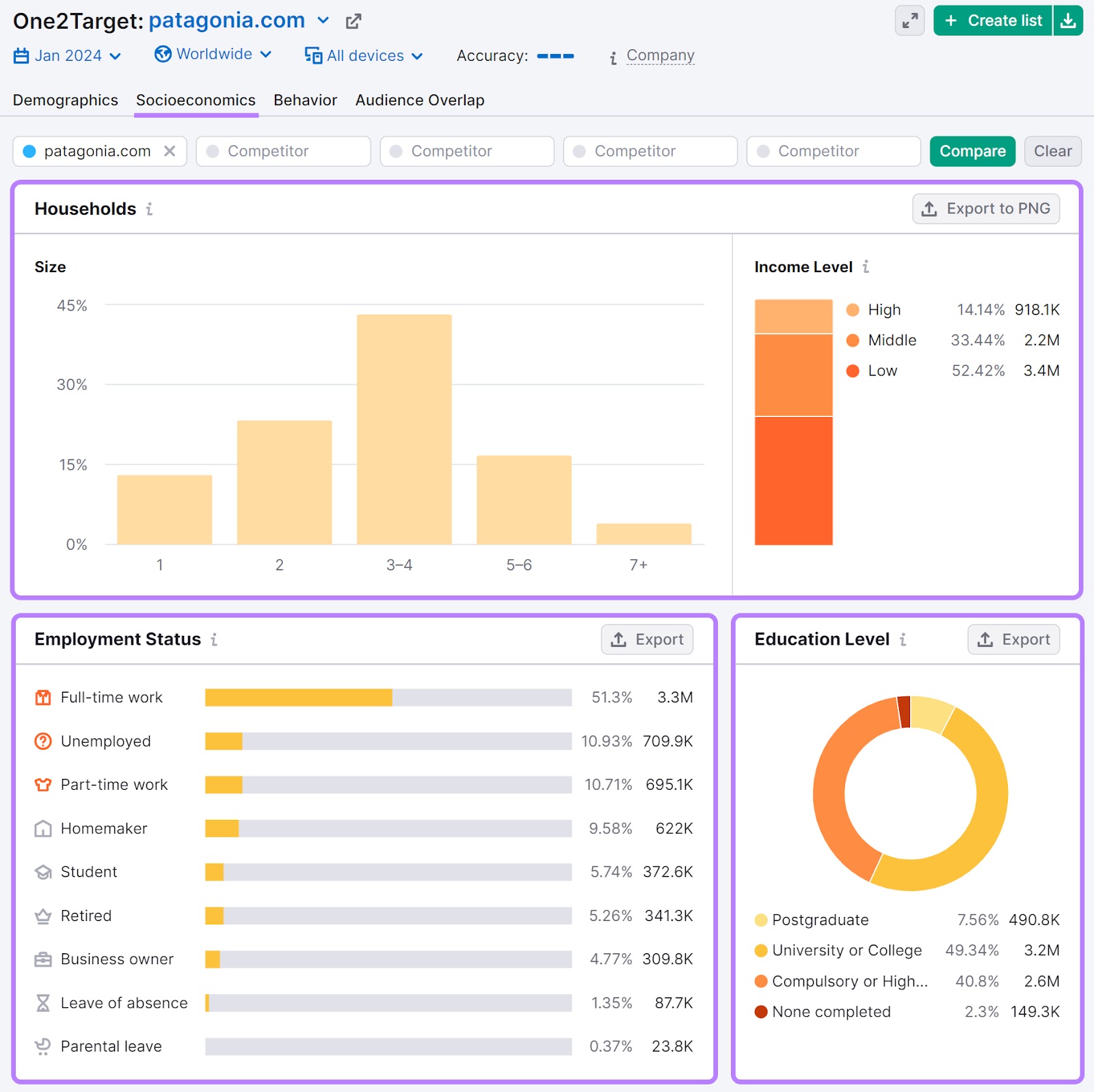
And this is its “Behavior” data:
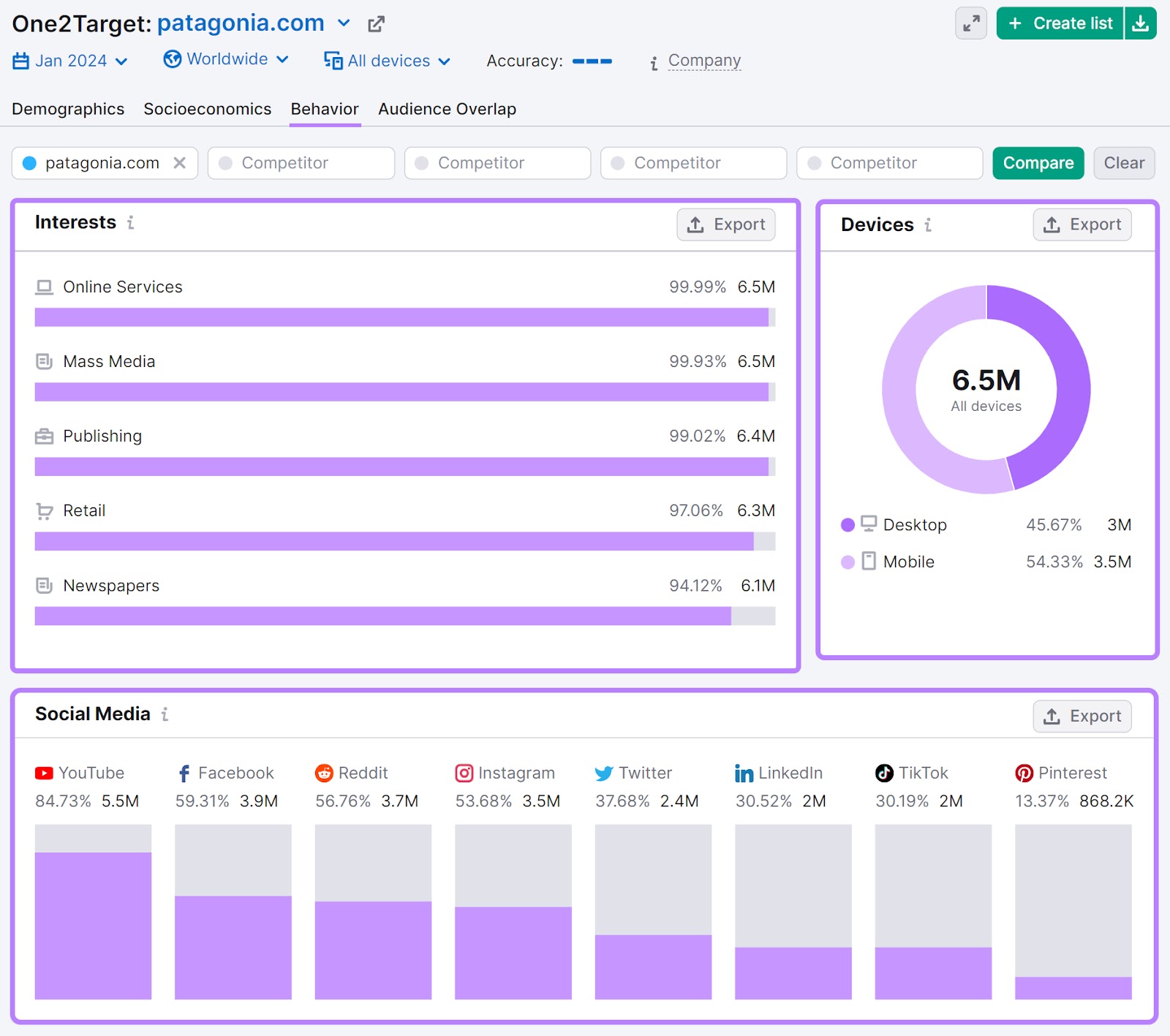
What we see above consolidates the data from Rapanui’s audience breakdown. Most of Patagonia’s target customers are also college-educated, full-time workers with a low-to-middle income. They share the same preferred social channels, too. Showing a consistent target market across competitors.
This competitor analysis helps you gain key insights into your potential customer base and who you’re up against.
Access even more granular psychographic data with Semrush’s Audience Intelligence app.
The tool classifies your audience by personality types, online habits, media affinities, and top influencers. As well as providing demographic and socioeconomic insights.
Enter your brand’s X (formerly Twitter) handle to create a report.
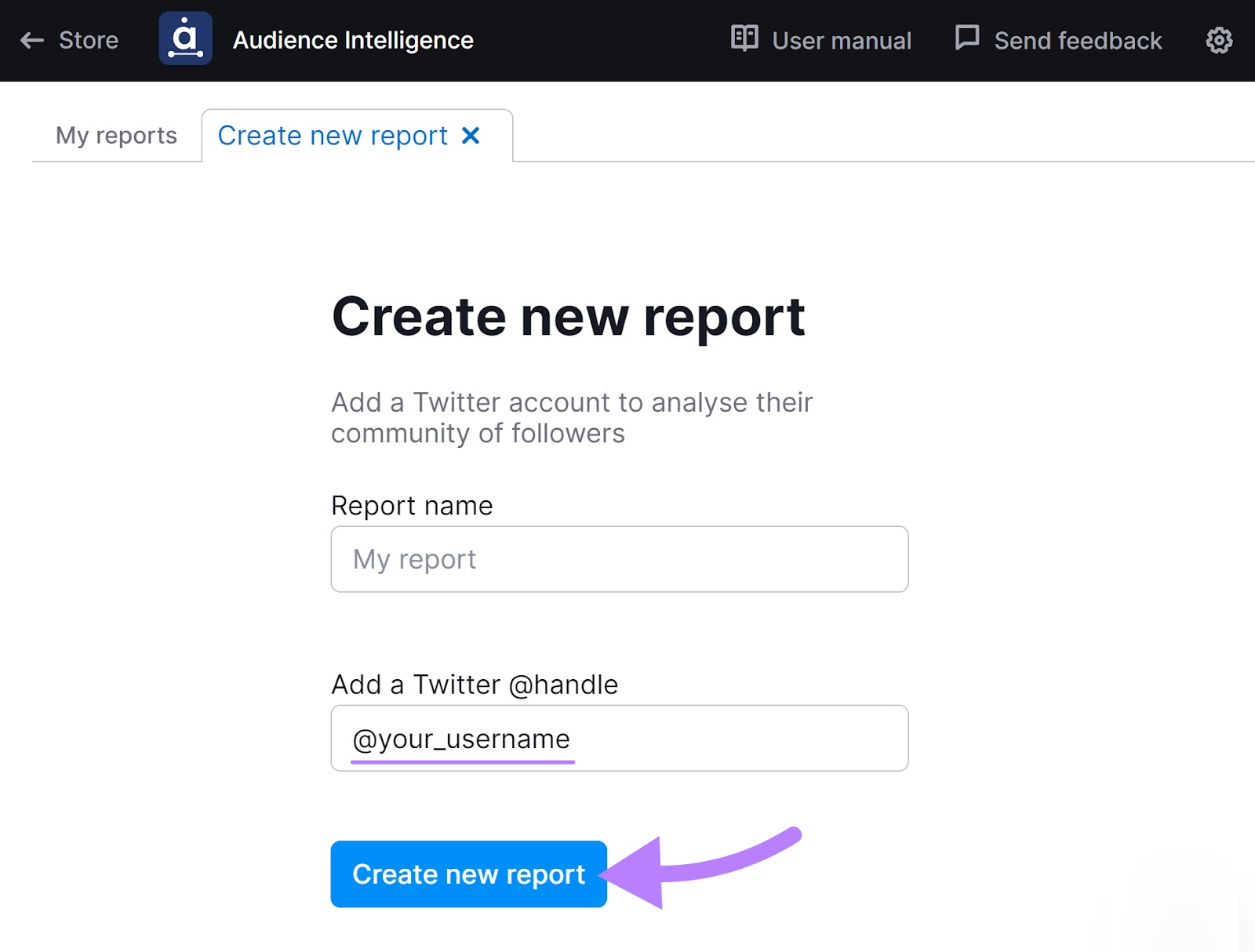
The main report dashboard gives you an overview of your audience’s demographics, top brands, influencers, and content sources. Together with a visualization of your main audience segments.
Here’s what the report looks like for sportswear brand Lululemon. Click “See all segments” to explore your audience in more detail.
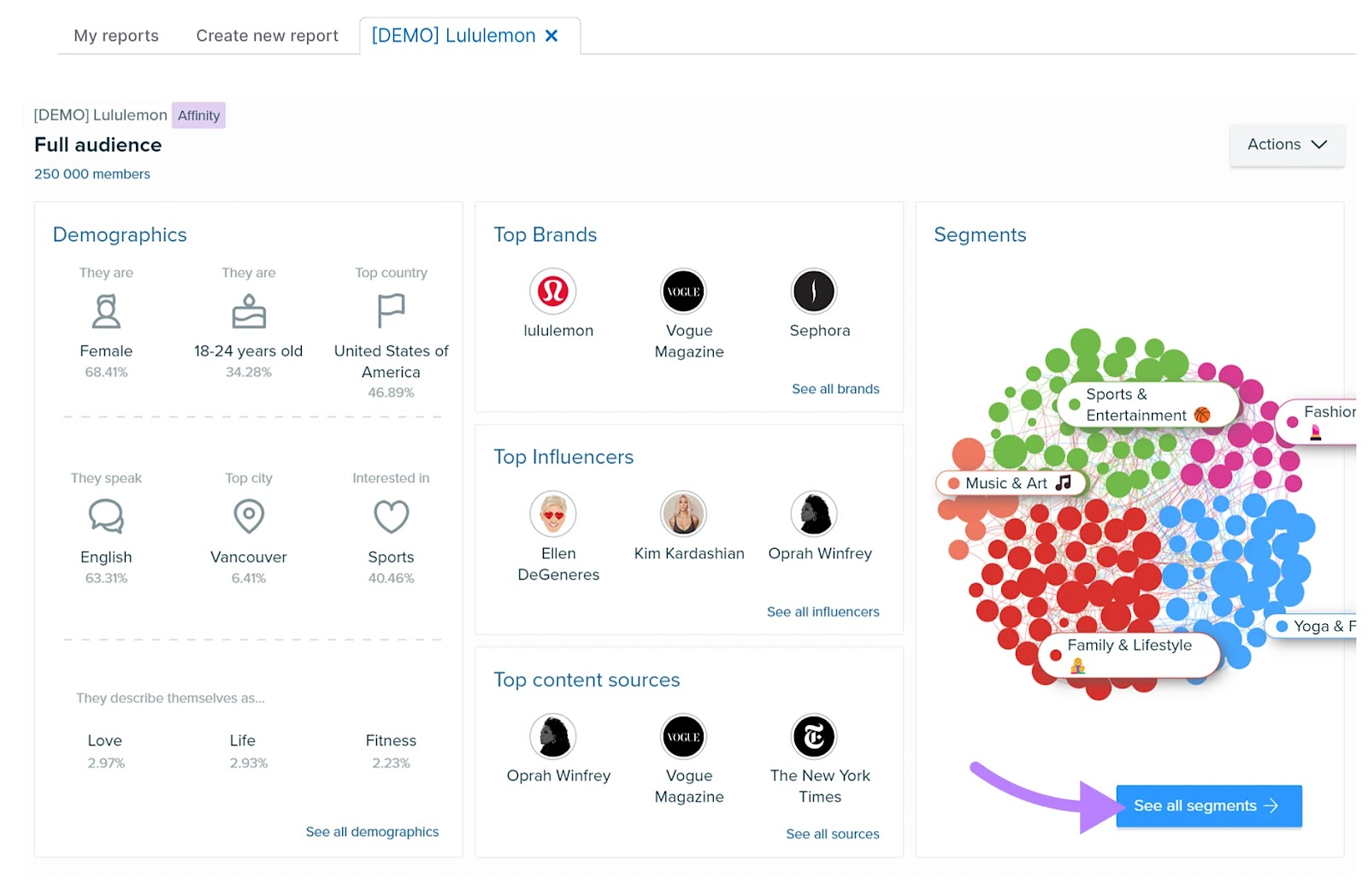
The interactive graph on the left clusters people into segments based on shared affinities and interests. By grouping followers of similar online accounts.
On the right, you’ll find additional audience data. Including a breakdown of top keywords found in their bios, a summary of their top influencers and content sources, and a list of the top hashtags they use.
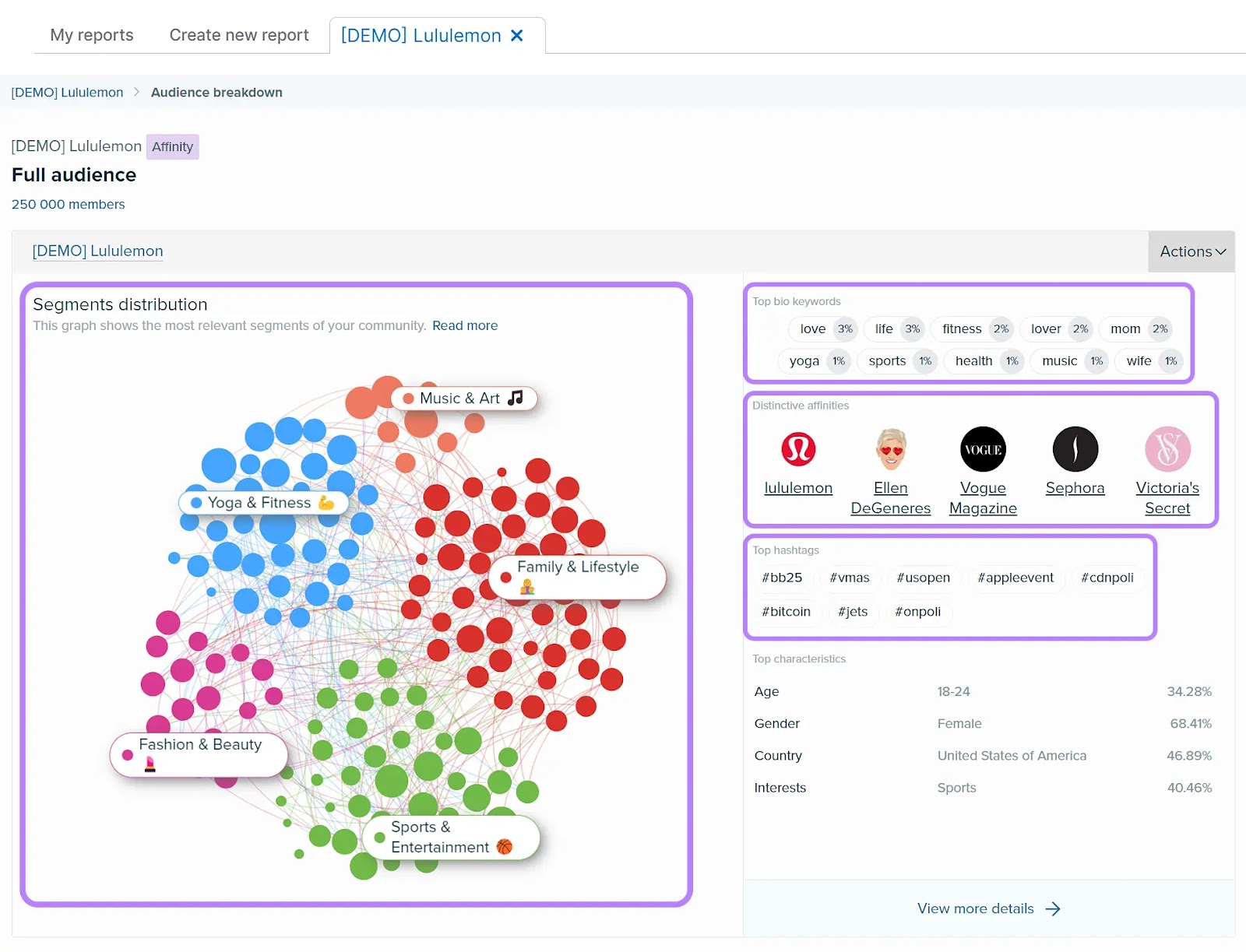
Scroll down to see the segment cards—giving you a top-level overview of each segment’s unique characteristics. Click on any card to compare that segment with your broader audience.
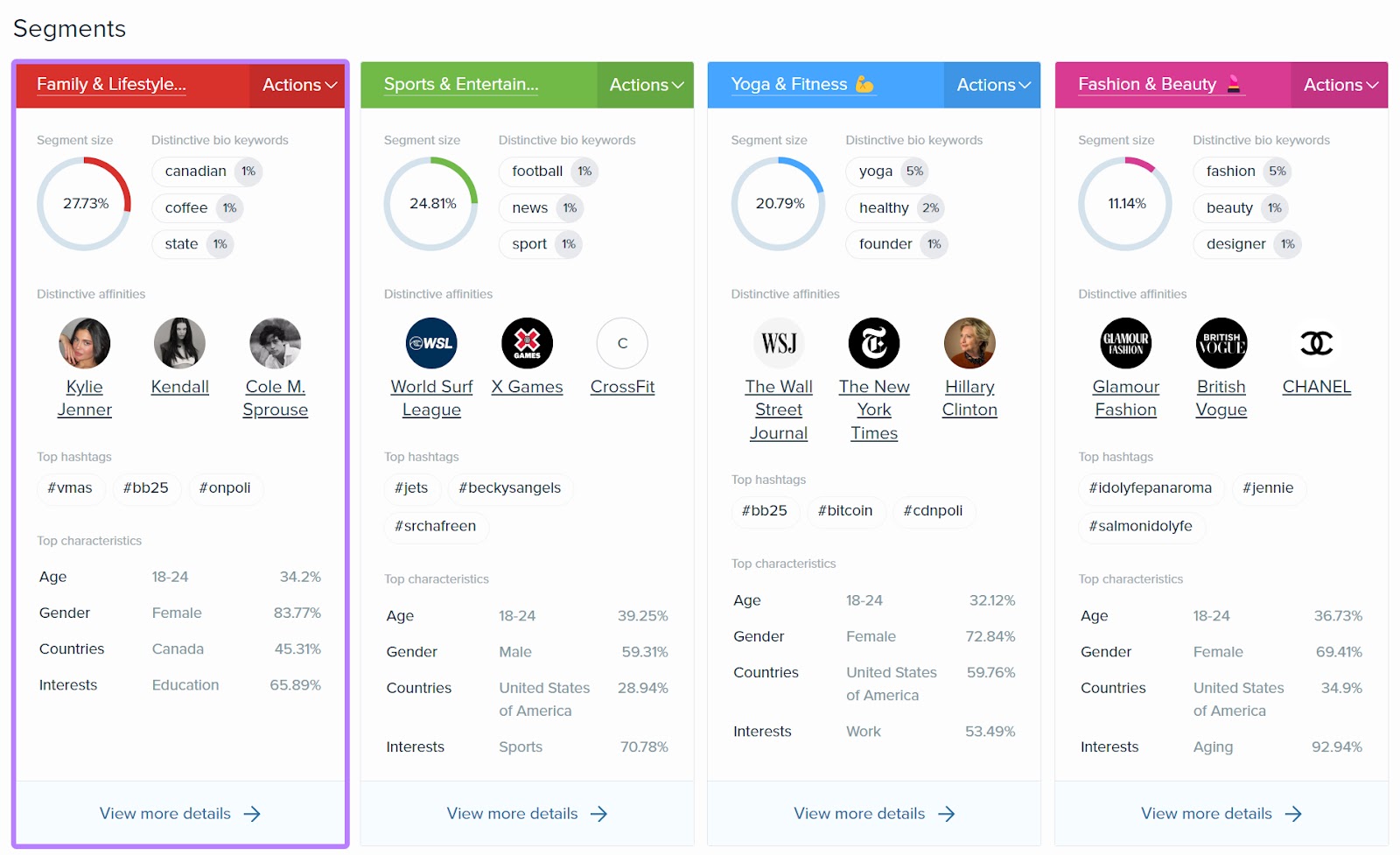
This takes you to the “Audience Breakdown” dashboard, featuring nine sections of in-depth data including “Interests,” “Media affinity,” and "Buying mindset.”
Let’s look at the “Buying mindset” for Lululemon’s “Family & Lifestyle” segment.
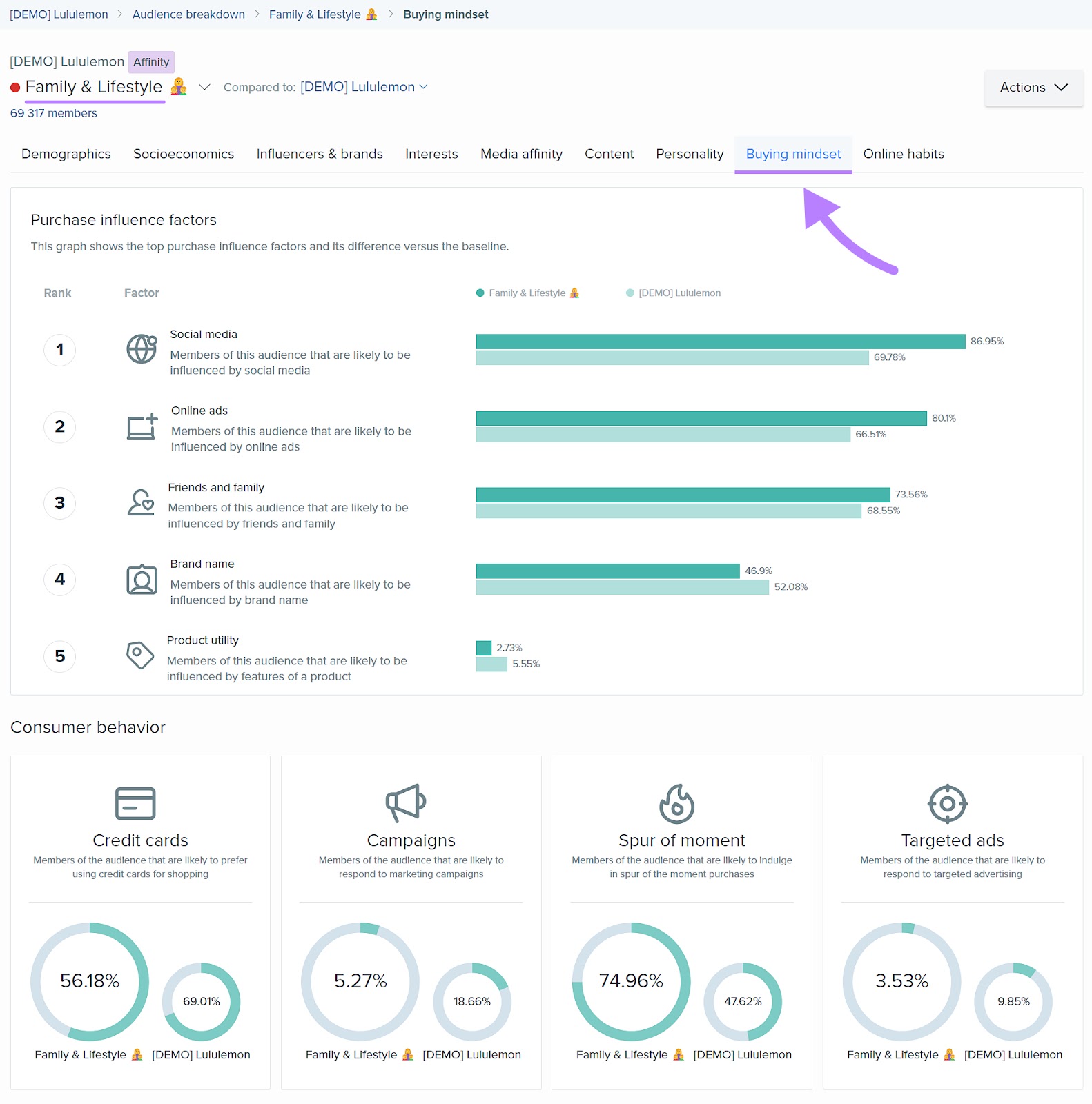
Compared to Lululemon’s broader audience, the “Family & Lifestyle” segment is more likely influenced by social media, online ads, friends, and family. It’s also more inclined to make spur-of-the-moment buying decisions.
With these insights, Lululemon could target the segment with Instagram ads promoting limited-time offers on selected items.

Review Your Website Analytics
An analytics platform like Google Analytics 4 (GA4) doesn’t provide direct psychographic data about your website visitors. Still, you can sometimes infer user preferences by observing their online engagement patterns.
Imagine you own a cosmetics company, and you’re considering whether to expand your eco-friendly product ranges.
Here’s some context.
While your customers don’t explicitly express interest in eco-friendly cosmetics, you notice that many of them consistently purchase your sustainable options and spend time reading your brand’s environmental policies.
Then it’s safe to assume they prefer “green” options.
The Google Analytics Audiences feature lets you group visitors based on their shared attributes, including how they interact with your site. Which results in creating a custom audience.
When you share an audience with Google Ads, you can retarget that specific group of users with a more personalized ad campaign.
Imagine you create a custom audience of all users who have viewed your site’s sustainability section but haven’t made a purchase. You label this audience “Eco-conscious non-buyers.”

From there, you could run retargeting ad campaigns for that specific audience, highlighting your brand’s range of eco-friendly products.
Conduct Digital Surveys and Questionnaires
Surveys and questionnaires are a relatively quick and inexpensive way to collect psychographic data from a large sample of your target market.
There are tons of high-quality digital survey platforms to choose from, such as Qualtrics, SurveyMonkey, and Google Forms (below).
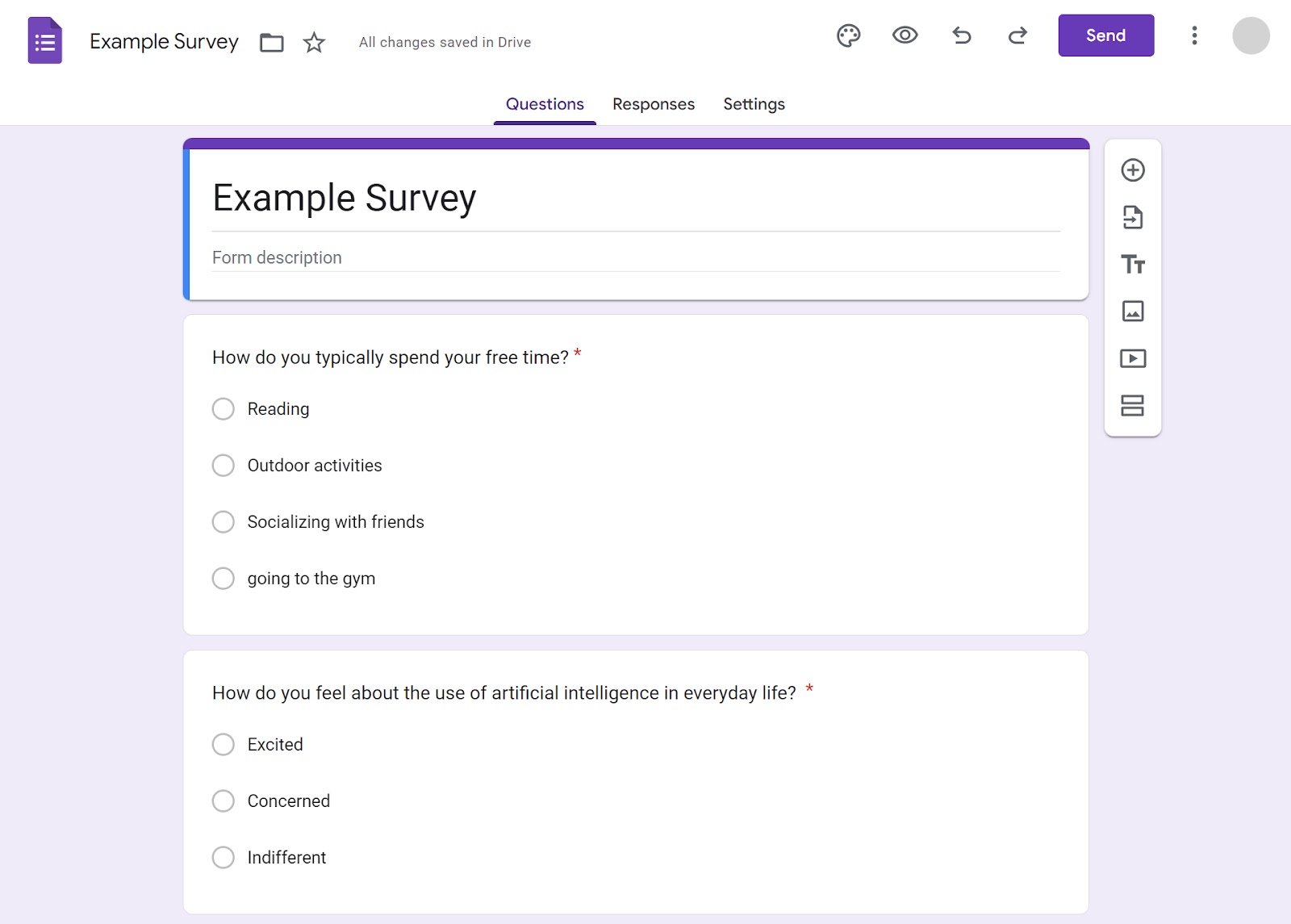
The key is to design your surveys and questionnaires with clear, targeted questions that directly address the psychographic dimensions you’re interested in exploring.
For example:
- How do you typically spend your free time? (Options: reading, outdoor activities, socializing with friends, going to the gym, etc.)
- How do you feel about the use of artificial intelligence in everyday life? (Options: excited, concerned, indifferent, etc.)
- To what extent do you agree with the statement: “It’s important for me to contribute to environmental conservation”? (Scale from ‘strongly agree’ to ‘strongly disagree’)
- What do you care about most when buying [product category]? (Options: quality, price, brand reputation, social status, etc.)
Important: Lengthy surveys with multiple open-ended questions could result in lower completion rates. Keep them as brief as possible and focus on yes/no and multiple-choice answers.
You’ll also need a big enough sample size to ensure statistically significant results.
If you’re having trouble securing enough responses, consider incentivizing participants with free products, gift cards, or discount codes.
Interview Customers for Deep Psychographic Profiling
Conduct non-scripted, one-on-one interviews with a few existing customers to uncover hidden insights into their preferences and motivations.
The goal here is to let participants provide deep, unguided responses that reveal the nuances of their wants, needs, and how they relate to your brand.
It’s a good idea to start with broad questions about participants’ values and experiences. Gradually nudge the conversation to a discussion about your products or services.
This approach lets you place customers’ opinions about your brand within the broader context of their lifestyle and beliefs.
Run Focus Groups for Broad Psychographic Perspectives
A focus group involves having a group discussion between you and members of your target market. These can be conducted in person or online.
As with one-to-one interviews, you aim to encourage all participants to openly share their perspectives and experiences. Diving deeper into relevant topics as they come up.
Focus groups often reveal a wide range of psychographic perspectives.
For example, some members may bring up how they consider a brand’s social impact before doing business with them. Or express a strong preference for brands that are upfront and transparent in their communication.
Others may indicate a preference for experiences over physical possessions.
Since strong personalities can easily dominate group discussions, your moderator must ensure everyone feels free to express their views.
Collaborate With Your Sales and Customer Service Teams
Promoting closer collaboration between customer-facing teams helps you compile valuable customer data that would otherwise remain compartmentalized within your business.
Understanding how customers think doesn’t only concern marketers.
Sales teams spend their days overcoming objections and discovering what makes customers tick. They can:
- Identify which aspects of your offering are most important to your customers
- Reveal common preconceptions about your brand that make prospects think twice before doing business with you
Meanwhile, customer service teams are the first to hear about your customers’ concerns and criticisms. They’re in a prime position to point out where your product or service excels or falls short of expectations.
For example, customers often give feedback on features they feel should be added or improved—shedding light on their underlying needs and desires.
How to Use Psychographics in Marketing Strategies
Now that we’ve covered the basic components of psychographic research, let’s consider two core applications of psychographic marketing.
Identify Target Audiences and Personas with Psychographics
Your next step once you’ve collected psychographic insights from various sources is to consolidate and analyze the data. This helps you identify any distinct psychographic profiles that make up your target audience.
Pool all your collected data into a centralized database or customer relationship management (CRM) system. Categorize each data point based on the psychographic criteria we mentioned earlier—like lifestyle, personality, and interests.
Now, you’ll need to conduct data analysis to see where these criteria overlap among your audience. For this step, we strongly recommend seeking the support of an experienced data analyst. This could be an existing in-house team member, a new hire, or a part-time contractor.
Going back to our eco-friendly cosmetics brand example, you might find that a significant portion of your audience not only values sustainability, but also leads a physically active lifestyle.
Once you’ve identified these overlapping criteria, start defining distinct audience segments or buyer personas. To target different parts of your audience with offers and messaging that resonate with them most.
Further reading: How to Create Your Buyer Personas: the What, the Why, and the How
Each persona represents a group within your target market that shares specific psychographic characteristics. Develop detailed personas for each segment, highlighting how their psychographic characteristics influence their purchasing decisions, media consumption, and engagement with brands.
Here’s what you might want to base a buyer persona named “Eco-Conscious Consumer” on:
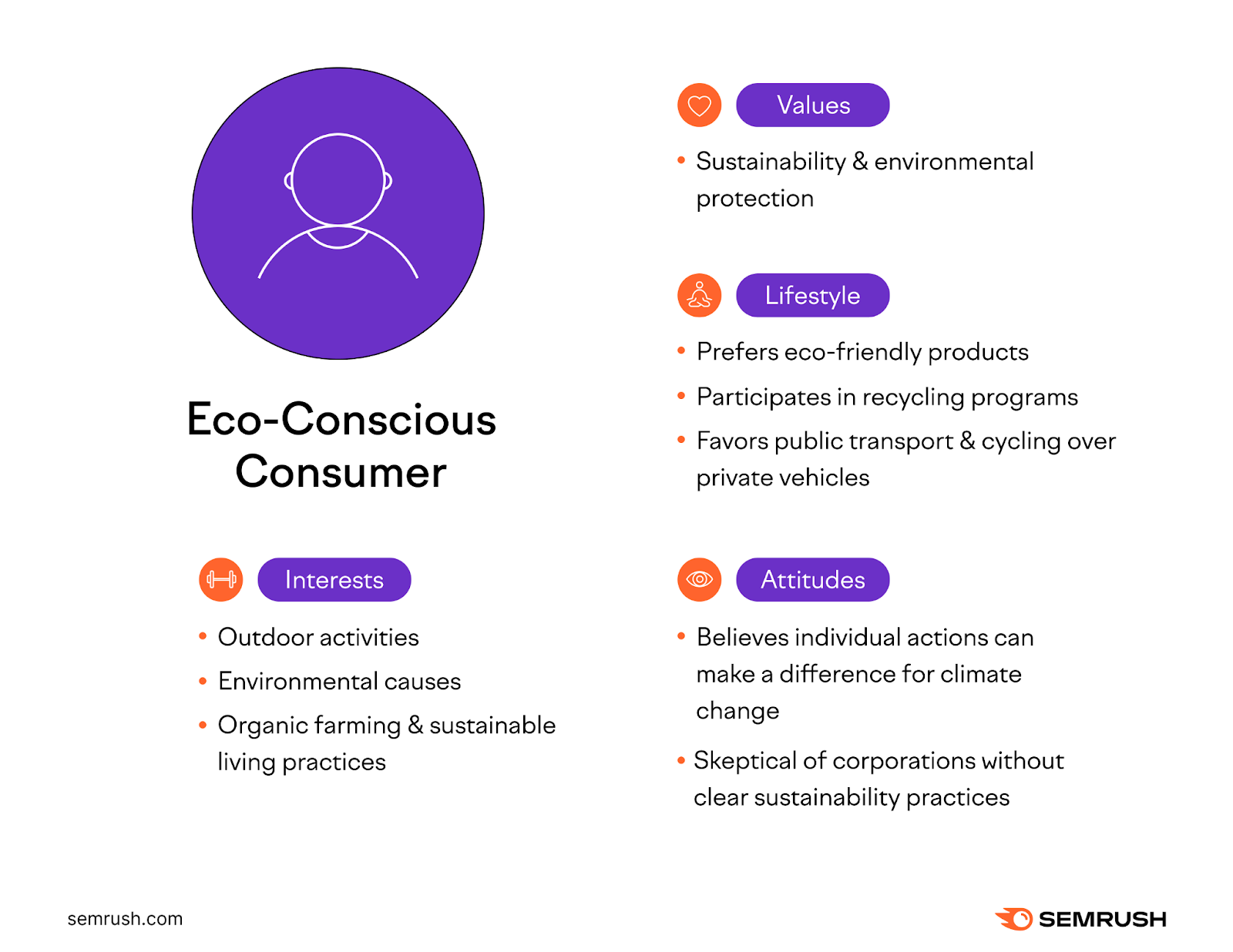
Tailor Marketing Messages Based on Psychographic Data
After defining and developing your psychographic personas, start adjusting your messaging and personalizing content for each customer type (assuming you have more than one).
Further reading: Content Personalization: What It Is & How to Do It
The ideal outcome would be to tailor all forms of communication—web copy, email copy, landing pages, ads, sales scripts, blog posts—to resonate with each distinct psychographic segment.
But a more practical approach is to prioritize your efforts on the channels and content types most likely to influence the purchasing decisions of each persona. Think:
- Key landing pages: Develop customized landing pages to appeal to the core values and interests of different personas. Pair your landing page copy with aspirational images, customer testimonials, and calls-to-action (CTAs) that speak directly to the motivations and desires of each customer type.
- Email campaigns: Segment your email list according to your specific psychographic profiles, ensuring your messages address the unique priorities and preferences of each group. Personalize your subject lines and share content and promotions specific to individual personas’ tastes.
- Segment-specific ads: Create targeted ad campaigns for each audience segment, featuring copy and imagery that caters to their distinct pain points, wants, and needs
Examples of Psychographic Marketing in Action
In this section, we look at what psychographic marketing looks like in the real world.
Nike’s ‘Dream Crazier’ Campaign
In 2019, Nike launched the “Dream Crazier” campaign as part of its broader “Just Do It” series.
The brand highlighted the challenges, stereotypes, and double standards women face in sports. Encouraging women to break barriers without fear of judgment—and redefining what’s possible.
At the heart of the initiative were real stories of female athletes who overcame significant challenges to achieve greatness in their sports.

“Dream Crazier” targeted a specific psychographic segment of Nike’s audience: female sports enthusiasts seeking empowerment through athletic endeavors despite societal pressures.
The campaign not only celebrated women’s sporting achievements, but also positioned Nike as a promoter of gender equality.
Airbnb’s ‘Live There’ Campaign
In 2016, Airbnb launched its “Live There” campaign. The goal was to differentiate the service from traditional hotel options by offering travelers a more authentic, local living experience.
The campaign featured a series of ads encouraging travelers to immerse themselves in local cultures and communities.

Image Source: Dexigner
It highlighted Airbnb’s unique value proposition: providing access to local homes and neighborhoods so travelers can live like locals, rather than tourists.
The “Live There” campaign targeted a distinct psychographic segment of travelers who prefer real cultural discoveries instead of what regular hotels offer.
By catering to these psychographic characteristics of its target market, Airbnb successfully positioned itself not only as an accommodation platform, but also as a gateway to authentic travel experiences.
Combining Psychographics with Demographics
Bringing together both psychographic and demographic insights to segment your audience will likely provide a more complete picture of who your consumers are. And what drives their buying decisions.
How so?
If you only factor in your audience’s demographic factors, you’ll struggle to pinpoint the “why” behind their consumer choices. If you only consider their psychographic characteristics, it can be difficult to accurately predict the size and viability of your market.
Consider a high-end organic grocery service that wants to attract consumers who value sustainable, organic products.
The business builds its entire targeting strategy on this psychographic profile without accounting for demographic factors—like location and income levels. The prices are at a premium and products are only available in certain cities.
Then, it turns out that most consumers live in rural areas and don’t have much disposable income.
The result? The grocery service fails to acquire many new customers.
This scenario shows the importance of a holistic approach to audience segmentation. Blending psychographics with demographics gives marketers a more nuanced understanding of the customers they want to target.
Convert More Customers with Psychographic Insights
Researching what makes consumers gravitate toward certain brands, buy their products, and stick around as loyal customers can greatly boost your marketing team’s efforts.
Psychographic research is the art of discovering what makes your audience tick. Customer interviews, sales team feedback, and research tools like Market Explorer, One2Target, and Audience Intelligence can all provide invaluable insights into the pains, needs, interests, and desires of your ideal customers.
When combining these insights with demographic data, you’ll be able to craft better offers, more persuasive campaigns, and, ultimately, grow your business.
Elevate your digital strategy with free access to audience insights tools and more from Semrush.
